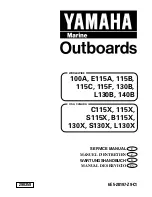
Appendix B
I/O Interface Board Description
36
Reference Manual
CoreModule 740
I/O Interface Board Connectors and Headers
The following tables define the pin signals of all the non-standard connectors and headers on the I/O
Interface Board. This appendix does not define industry-standard connectors on the board such as parallel,
DB9 serial, PS2 mouse and keyboard, and USB.
lists the signals and their descriptions for the Utility 1 interface which provides a shrouded 40-pin
header with odd/even (1, 2) pin sequence. The third column in this table denotes the corresponding pins
from the J5 header on the CoreModule 740.
NOTE
The CoreModule 740 does not support the Infrared header (J12) shown in
.
Table B-1. Utility 1 Interface Pin Signals (J1)
Pin #
Signal
From
J5
Pin #
Description
1
DCD1*
J5-1
Serial Data Carrier Detect 1 – Indicates external modem is detecting a
carrier signal (i.e., a communication channel is currently open). In
direct connect environments, this input will be driven by DTR1 as part
of the DTR1/DSR1 handshake.
2
DSR1*
J5-3
Serial Data Set Ready 1 – Indicates external serial communications
device is powered, initialized, and ready. Used as hardware handshake
with DTR1 for overall readiness to communicate.
3
RXD1
J5-5
Serial Receive Data 1 Input – This line is typically held at a logic 1
(mark) when no data is being transmitted, and is held “Off” for a brief
interval after an “On” to “Off” transition on the RTS1 line to allow the
transmission to complete.
4
RTS1*
J5-7
Serial Request To Send 1 – Indicates serial port is ready to transmit
data. Used as hardware handshake with CTS1 for low level flow
control.
5
TXD1
J5-9
Serial Transmit Data 1 Output – This line is typically held to a logic 1
when no data is being sent. Typically, a logic 0 (On) must be present
on RTS1, CTS1, DSR1, and DTR1 before data can be transmitted on
this line.
6
CTS1*
J5-11
Serial Clear To Send 1 – Indicates external serial communication
device is ready to receive data. Used as hardware handshake with
RTS1 for low level flow control.
7
DTR1*
J5-13
Serial Data Terminal Ready 1 – Indicates port is powered, initialized,
and ready. Used as hardware handshake with DSR1 for overall
readiness to communicate.
8
RI1*
J5-15
Serial Ring Indicator 1 – Indicates external modem is detecting a ring
condition. Used by software to initiate operations to answer and open
the communications channel.
9
GND
J5-17
Digital Ground
10
NC
J5-19
Not Connected
11
DCD2*
J5-21
Serial Data Carrier Detect 2 – Indicates external modem is detecting a
carrier signal (i.e., a communication channel is currently open). In
direct connect environments, this input will be driven by DTR2 as part
of the DTR2/DSR2 handshake.







































